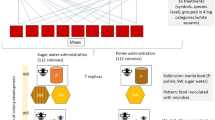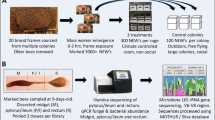Abstract
Social pollinators, like honeybees and bumblebees, have specific microbiota. The specific association between the insect and its gut microbiota could lead to a functional dependence. In this project, we investigated whether an alteration in microbiota could influence the fitness of the generalist pollinator Bombus terrestris. We used bumblebee workers in microcolonies to assess effects on colony development and reproduction. Treatment with 200 ppm streptomycin and tetracycline resulted in a disruption of gut microbiota, and typically there was 100 % worker mortality. In contrast, treatment with streptomycin alone showed an improved reproduction and this concurred with a different gut microbiota pattern. The results are discussed in relation to effects of the gut microbiota on bumblebee fitness and potential beneficial effects by Lactobacillus sp. These data may open new avenues in the mass-rearing of bumblebees used for the biological pollination in agriculture.




Similar content being viewed by others

References
Aizen, M.A., Garibaldi, L.A., Cunningham, S.A., Klein, A.M. (2008) Long-term global trends in crop yield and production reveal no current pollination shortage but increasing pollinator dependency. Curr. Biol. 18(20), 1572–1575
Babendreier, D., Joller, D., Romeis, J., Bigler, F., Widmer, F. (2007) Bacterial community structures in honeybee intestines and their response to two insecticidal proteins. FEMS Microbiol. Ecol. 59(3), 600–610
Bakke, I., De Schryver, P., Boon, N., Vadstein, O. (2011) PCR-based community structure studies of bacteria associated with eukaryotic organisms: A simple PCR strategy to avoid co-amplification of eukaryotic DNA. J. Microbiol. Meth. 84(2), 349–351
Breeuwer, J.A., Werren, J.H. (1990) Microorganisms associated with chromosome destruction and reproductive isolation between two insect species. Nature 346(6284), 558–560
Broderick, N.A., Raffa, K.F., Goodman, R.M., Handelsman, J. (2004) Census of the bacterial community of the gypsy moth larval midgut by using culturing and culture-independent methods. Appl. Environ. Microbiol. 70(1), 293–300
Brownlie, J.C., Johnson, K.N. (2009) Symbiont-mediated protection in insect hosts. Trends Microbiol. 17(8), 348–354
Chandler, J. A., Lang, J. M., Bhatnagar, S., Eisen, J. A., Kopp, A. (2011) Bacterial communities of diverse Drosophila species: Ecological context of a host-microbe model system. PLoS Genetics 7(9) doi:10.1371/journal.pgen.1002272
Clarke, K.R. (1993) Nonparametric multivariate analyses of changes in community structure. Aust J Ecol 18(1), 117–143
Clarke, K.R., Green, R.H. (1988) Statistical design and analysis for a biological effects study. Mar. Ecol. Progr. 46(1–3), 213–226
Corby-Harris, V., Pontaroli, A.C., Shimkets, L.J., Bennetzen, J.L., Habel, K.E., Promislow, D.E.L. (2007) Geographical distribution and diversity of bacteria associated with natural populations of Drosophila melanogaster. Appl. Environ. Microbiol. 73(11), 3470–3479
Dillon, R.J., Vennard, C.T., Buckling, A., Charnley, A.K. (2005) Diversity of locust gut bacteria protects against pathogen invasion. Ecol. Lett. 8(12), 1291–1298
Engel, P., Martinson, V.G., Moran, N.A. (2012) Functional diversity within the simple gut microbiota of the honey bee. Proc. Natl. Acad. Sci. U S A 109(27), 11002–11007
Forsgren, E., Olofsson, T.C., Vasquez, A., Fries, I. (2010) Novel lactic acid bacteria inhibiting Paenibacillus larvae in honey bee larvae. Apidologie 41(1), 99–108
Ghazoul, J. (2005) Buzziness as usual? Questioning the global pollination crisis. Trends Ecol. Evol. 20(7), 367–373
Klungness, L.M., Peng, Y.S. (1984) A histochemical-study of pollen digestion in the alimentary canal of honeybees (Apis mellifera L). J. Insect Physiol. 30(7), 511–521
Koch, H., Schmid-Hempel, P. (2011a) Bacterial communities in central European bumblebees: Low diversity and high specificity. Microb. Ecol. 62(1), 121–133
Koch, H., Schmid-Hempel, P. (2011b) Socially transmitted gut microbiota protect bumble bees against an intestinal parasite. Proc. Natl. Acad. Sci. U S A 108(48), 19288–19292
Koch, H., Abrol, D.P., Li, J., Schmid-Hempel, P. (2013) Diversity and evolutionary patterns of bacterial gut associates of corbiculate bees. Mol. Ecol. 22(7), 2028–2044
Martinson, V.G., Danforth, B.N., Minckley, R.L., Rueppell, O., Tingek, S., Moran, N.A. (2011) A simple and distinctive microbiota associated with honey bees and bumble bees. Mol. Ecol. 20(3), 619–628
Marzorati, M., Wittebolle, L., Boon, N., Daffonchio, D., Verstraete, W. (2008) How to get more out of molecular fingerprints: practical tools for microbial ecology. Environ. Microbiol. 10(6), 1571–1581
McKee, E.E., Ferguson, M., Bentley, A.T., Marks, T.A. (2006) Inhibition of mammalian mitochondrial protein synthesis by oxazolidinones. Antimicrob. Agents Chemother. 50(6), 2042–2049
Mertens, B., Boon, N., Verstraete, W. (2005) Stereospecific effect of hexachlorocyclohexane on activity and structure of soil methanotrophic communities. Environ. Microbiol. 7(5), 660–669
Mommaerts, V., Sterk, G., Smagghe, G. (2006) Hazards and uptake of chitin synthesis inhibitors in bumblebees Bombus terrestris. Pest. Manag. Sci. 62(8), 752–758
Moran, N.A., McCutcheon, J.P., Nakabachi, A. (2008) Genomics and evolution of heritable bacterial symbionts. Annu. Rev. Genet. 42, 165–190
Mohr, K.I., Tebbe, C.C. (2007) Field study results on the probability and risk of a horizontal gene transfer from transgenic herbicide-resistant oilseed rape pollen to gut bacteria of bees. Appl. Microbiol. Biotechnol. 75(3), 573–582
Moter, A., Göbel, U.B. (2000) Fluorescence in situ hybridization (FISH) for direct visualization of microorganisms. J. Microbiol. Meth. 41(2), 85–112
Peng, Y.S.C., Mussen, E., Fong, A., Montague, M.A., Tyler, T. (1992) Effects of chlortetracycline of honey-bee worker larvae reared in vitro. J Invert. Pathol. 60(2), 127–133
Riegler, M., O'Neill, S.L. (2007) Evolutionary dynamics of insect symbiont associations. Trends Ecol. Evol. 22(12), 625–627
Soccol, C.R., Vandenberghe, L.P.D., Spier, M.R., Medeiros, A.B.P., Yamaguishi, C.T., Lindner, J.D., Pandey, A., Thomaz-Soccol, V. (2010) The potential of probiotics: a review. Food. Tech. Biotechnol. 48(4), 413–434
Steffan-Dewenter, I., Potts, S.G., Packer, L. (2005) Pollinator diversity and crop pollination services are at risk. Trends Ecol. Evol. 20(12), 651–652
Van de Wiele, T., Boon, N., Possemiers, S., Jacobs, H., Verstraete, W. (2004) Prebiotic effects of chicory inulin in the simulator of the human intestinal microbial ecosystem. FEMS Microbiol. Ecol. 51(1), 143–153
Vasquez, A., Forsgren, E., Fries, I., Paxton, R.J., Flaberg, E., Szekely, L., Olofsson, T.C. (2012) Symbionts as major modulators of insect health: Lactic acid bacteria and honeybees. PLoS One 7(3), e33188. doi:10.1371/journal.pone.0033188
Velthuis, H.H.W., van Doorn, A. (2006) A century of advances in bumblebee domestication and the economic and environmental aspects of its commercialization for pollination. Apidologie 37(4), 421–451
Vervaeren, H., Temmerman, R., Devos, L., Boon, N., Verstraete, W. (2006) Introduction of a boost of Legionella pneumophila into a stagnant-water model by heat treatment. FEMS Microbiol. Ecol. 58(3), 583–592
Weinstock, G.M., Robinson, G.E., Gibbs, R.A., Worley, K.C., Evans, J.D., et al. (2006) Insights into social insects from the genome of the honeybee Apis mellifera. Nature 443(7114), 931–949
Wilkinson, T.L. (1998) The elimination of intracellular microorganisms from insects: an analysis of antibiotic-treatment in the pea aphid (Acyrthosiphon pisum). Comp. Biochem. Physiol. Mol. Integr. Physiol. 119(4), 871–881
Wittebolle, L., Marzorati, M., Clement, L., Balloi, A., Daffonchio, D., Heylen, K., Vos, P.D., Verstraete, W., Boon, N. (2009) Initial community evenness favors functionality under selective stress. Nature 458, 623–626
Acknowledgments
This study was supported by the Fund for Scientific Research Flanders (FWO-Vlaanderen) and the Institute for the Promotion of Innovation by Science and Technology in Flanders (IWT, Brussels, Belgium). H. Mosallanejad is now staff of Iranian Research Institute of Plant protection which is acknowledged.
Author information
Authors and Affiliations
Corresponding author
Additional information
Evaluation du mutualisme entre Bombus terrestris et son microbiote grâce à l’utilisation de micro-colonies
Interactions hôte-micro-organisme / pollinisateur / insecte social / Bombus terrestris / streptomycine / Lactobacillus / probiotique
Abschätzung des Mutualismus zwischen Bombus terrestris und seinen Mikrobioten durch Verwendung von Mikrokolonien
Wirt-Mikroben-Interaktionen / soziale Bestäuber / Bombus terrestris / Streptomycin / Lactobacillus / Probiota
Electronic supplementary material
Below is the link to the electronic supplementary material.
ESM 1
(PDF 12 kb)
Rights and permissions
About this article
Cite this article
Meeus, I., Mommaerts, V., Billiet, A. et al. Assessment of mutualism between Bombus terrestris and its microbiota by use of microcolonies. Apidologie 44, 708–719 (2013). https://doi.org/10.1007/s13592-013-0222-9
Received:
Revised:
Accepted:
Published:
Issue Date:
DOI: https://doi.org/10.1007/s13592-013-0222-9



